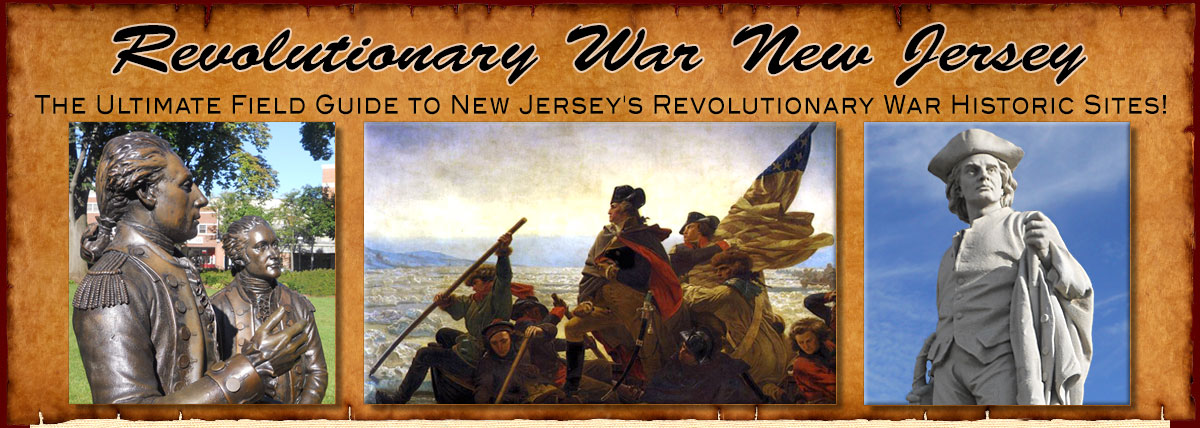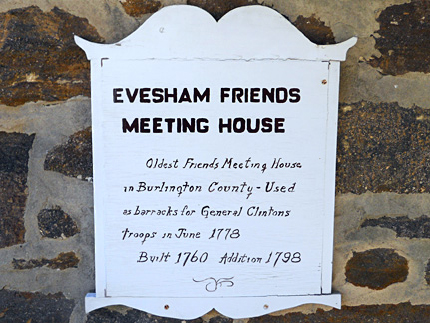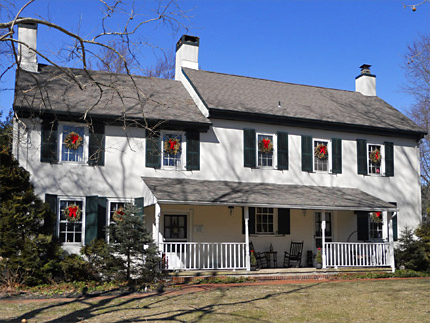



Evesham Friends Meeting House
Moorestown-Mount Laurel Rd. and Hainesport-Mt. Laurel Rd.
Click here for Map / Directions
The Evesham Friends Meeting House was built in 1760. The section of the building which can be seen at the left of the photo above was added in 1798. [1]
Because Quakers are pacifists, they generally took no side in the Revolutionary War, and they wished to have nothing to do with it. However, the location of this Quaker meeting house placed it in the line of march of British troops in June 1778. As described below, this resulted in British soldiers occupying this meeting house for one night.
The British army occupied Philadelphia from September 26, 1777 until June 18, 1778. Philadelphia had been serving as the American capital, and the British occupation forced Congress to move to York, Pennsylvania, which had a demoralizing effect on the Americans.
During that same winter of 1777, General George Washington and his Continental (American) army were camped about twenty miles away from Philadelphia in Valley Forge, Pennsylvania. Valley Forge provided a good strategic location for the army's winter quarters: It was close enough to keep an eye on the British troops in Philadelphia, but in a strong defensive position should the British decide to attack.
In early June 1778, the British forces in Philadelphia decided to abandon Philadelphia and march towards New York City, the main British stronghold in America. British forces under General Henry Clinton began their trip on June 18, 1777, when they crossed over the Delaware River into New Jersey, landing at Coopers Ferry (now Camden). They then marched as far as Haddonfield where they encamped for the night. The following day, they marched through a heavy rainstorm into this area, which was then part of Evesham, where they spent the night of June 19, 1778. British troops encamped around the area of this Friends Meeting House. The same night, Hessian troops were encamped about five miles away on the grounds of the Moorestown Friends Meeting House. (Hessians were German mercenary soldiers hired by the British to fight on their side in the Revolutionary War.)
During this time, General Washington and his Continental Army were also on the move. After hearing of the British evacuation of Philadelphia, Washington made the decision to leave Valley Forge. On June 20, they crossed into New Jersey at Coryell's Ferry and marched in pursuit of the British troops, keeping a path miles to the north of them.
From Mount Laurel, the British troops moved on through Mount Holly, Bordentown and Crosswicks. On June 28, they met the Continental Army at Monmouth Courthouse and fought the Battle of Monmouth, the longest continuous battle of the war. [2]


General Clinton House
1645 Hainesport-Mount Laurel Rd.
Click here for Map / Directions
This house is a private residence.
Please respect the privacy and property of the owners.
This house is believed to have been the headquarters of British General Henry Clinton on June 19, 1778, while his troops were encamped nearby on the grounds of the Evesham Friends Meeting House. (See above entry.) [3]

1. ^ National Register of Historic Places Inventory - Nomination Form for the Evesham Friends Meeting House.
Available as a PDF on the National Park Service website here.2. ^ For information placing Clinton's troops in this area on June 19, 1778, see:
• The Kemble Papers - Vol. 1 - 1773 -1789 in Collections of the New-York Historical Society for the Year 1883 (New York: New York Historical Society, 1884) pages 595-596
Available to be read at Google Books here
▸ General Clinton's orders for June 19 are marked "Eversham". The orders state that they will be marching out the following morning.• “To George Washington from Major General Philemon Dickinson, 19 June 1778,” Founders Online, National Archives (http://founders.archives.gov/documents/Washington/03-15-02-0489 [last update: 2015-06-29]). Source: The Papers of George Washington, Revolutionary War Series, vol. 15, May–June 1778, ed. Edward G. Lengel. Charlottesville: University of Virginia Press, 2006, pp. 472–473.
• “To George Washington from Major General Benedict Arnold, 21 June 1778,” Founders Online, National Archives (http://founders.archives.gov/documents/Washington/03-15-02-0506 [last update: 2015-06-29]). Source: The Papers of George Washington, Revolutionary War Series, vol. 15, May–June 1778, ed. Edward G. Lengel. Charlottesville: University of Virginia Press, 2006, pp. 485–486.
(Specifically, see "The enclosed letter from Howell to Maxwell, written on 20 June at Haddonfield, N.J" which appears in the footnote• William Stryker, The Battle of Monmouth, (First published in 1927; Reissued in 1970 by Kennikat Press, Port Washington, NY / London) pages 51-53
• Mt. Laurel was formed from a part of Evesham Township on March 7, 1872 by an act of the Legislature of the State of New Jersey.
• For the text of the act, see:
Acts of the Legislature of the State of New Jersey (Trenton: Naar, Day & Naar, "True American" Office, Printers, 1872) Pages 374-376
Available to be read at Google Books here• For additional information about the timeline of changes to Evesham Township, see:
John F. Snyder, The Story of New Jersey's Civil Boundaries: 1606-1968 (Trenton: Bureau of Geology and Topography, 1969) pages 95-96
Available as a PDF on the State of New Jersey website here. (Note that although the information is on pages numbered 95-96 of the document, it is on pages 102-103 of the PDF file.)• For more information and accompanying source notes about the Battle of Monmouth, see the Manalapan page of this website.
For more information and accompanying source notes about the British entry into New Jersey, see the Camden and Haddonfield pages.
3. ^ • Mount Laurel Historical Society sign on the house
• Historic American Buildings Survey - HABS-HJ-504 - General Clinton's Headquarters, Near Evesboro Mt. Laurel Township, Burlington County, New Jersey Photographs / Written Historical and Descriptive Data, District of New Jersey
Available on the Library of Congress website here▸ Note that these two sources are in disagreement as to the date and builder of the house.
The Mount Laurel Historical Society sign on the house states "Oldest portion built by Thomas Smith, Sr. 1738."
The Historic American Buildings Survey states "Built 1764 and circa 1780, by Abraham Matlack"